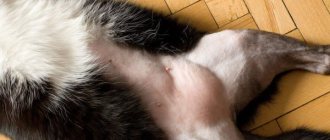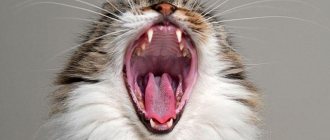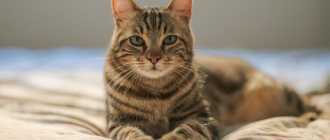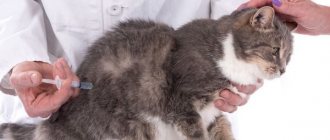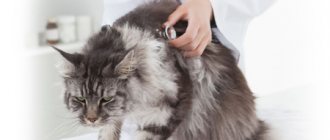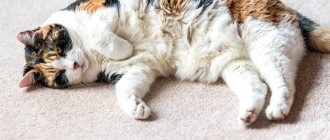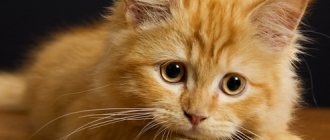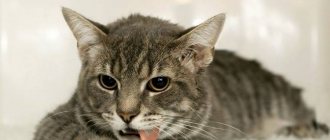Symptoms
Even an inexperienced owner will be able to determine the moment when his cat begins to go bald. During this period, the amount of animal fur in the apartment increases, and bald patches appear on parts of the pet’s body.
You can try to identify the causes of baldness on your own. To do this, you need to carefully examine your pet's skin. With some diseases, the animal may develop a characteristic itching. Your cat may often scratch the bald spot. More serious illnesses appear as sores, scabs, or peeling skin. In some cases, small bumps may appear.
Even if there are no visible reasons for a cat to have hair growing on its belly, it is necessary to take the animal to a veterinarian for a comprehensive examination.
The cat has lost hair on his belly
Recommended Posts
The cat's belly hair fell out, leaving only a short fluff. A “bald patch” has formed in the form of a triangle. The skin under the fluff is clean, pink, dense to the touch, there are two papillae on the sides. We noticed this about a month and a half ago, apparently he went bald at the end of summer.
The cat is 13 years old, no breed, neutered, not vaccinated, has not been ill with anything, active and cheerful, pees every day, poops once a week. We feed him all his life raw fish and meat, cucumbers, sometimes peas, etc., in the summer, grass from the street. Kitiket once a week. Doesn't go outside, only taken out a couple of times all summer.
“Yes, there is such an opinion among our brother. Not everything is so simple; very often even a good doctor underestimates diet therapy. In this matter I adhere to the opinion of BSAVA - the British Association of Small Animal Veterinary Medicine. This is, so to speak, a globally recognized brand of approach in global veterinary science.
Let me give you this example: So you give a cat a raw egg, a very healthy product, both proteins and fats and amino acids, but the egg contains avidin, which is killed by biotin, by the way, this can be the cause of baldness. Or you give your cat vitamin B1 and sea fish, such as cod, or just fish oil, which is healthy, but sea fish and fish oil contain the enzyme thiaminase, which simply breaks down vitamin B1. These substances are called antivitamins and are sometimes found in healthy foods. And the type of feeding that you use is called unbalanced feeding. In addition to antivitamins, many minerals compete with each other in the body, for example calcium with phosphorus, etc. The result of their mutual competition is a violation of bone mineralization in kittens, the so-called juvenile osteopenia of kittens.
Well, in the end, you must agree that those who advocate for straight women do not take into account that porridge and the whole list of that horror
Source
Diagnostics
It's not always easy to understand why a cat suddenly started going bald. Usually the exact cause of the pathology is established by excluding all possible causes for baldness.
It is worth carefully examining the animal, paying special attention to the abdomen, hind and front legs. It is necessary to assess the condition of the hairs in the coat. Also estimate how large an area is affected by the patch of baldness. Is there a border to the bald area, or has the animal’s coat simply thinned out? It is necessary to exclude infectious and fungal infections of the skin.
If your cat has recently had surgery, alopecia may occur at the site of the suture. Sometimes hair falls out in areas of the body where the animal has been injected with medications.
INTERESTING TO KNOW: Problems with eye suppuration in cats
A fairly common reason for a cat going bald on its legs or belly is fleas. If an animal unprotected from parasites walked on the street, then it could easily pick up fleas. Their bites often cause the cat's belly, back and legs to go bald. If fleas are found in an animal's fur, it is necessary to immediately treat it with special preparations.
If all the most likely causes have already been considered, but none of them are suitable, then it is best to contact a veterinarian for a diagnosis.
How to treat baldness
How to treat alopecia largely depends on the diagnosis. Many mustachioed owners, when they see a bald area, scream in horror - “deprivation!” and begin to look for something to anoint. The approach is completely wrong.
For feline alopecia, complex treatment is most often prescribed. Local therapy is indicated if there is a bacterial or fungal infection.
The algorithm is as follows:
- Treatment of the underlying disease that causes hair loss in cats.
- If skin parasites are identified, drops, tablets, and shampoos are prescribed to get rid of them. The prognosis is good if antiparasitic treatments are carried out regularly.
- For infections, a course of antibiotics.
- In case of an allergic reaction, the allergen is eliminated. If your cat has a food allergy, review the diet and eliminate it. The prognosis is good if the food is chosen correctly. If the allergen is not identified, the prognosis for recovery is cautious.
- If it's stress, the cause should be ruled out. With proper behavior correction, the prognosis is satisfactory. The therapy is long-term and requires patience from the owner.
- If tumors occur, surgical intervention is required. Timely surgery gives the right to make a positive prognosis. In advanced cases, the animal is not operated on.
Regardless of the reason, it is additionally necessary to strengthen the animal’s immunity. Sometimes the question arises about selecting a diet in accordance with age, state of health, and physiology.
Treatment
As a rule, an accurate diagnosis for balding cats is made by a veterinarian. He also prescribes the necessary treatment. It is usually aimed at treating hair loss and combating the underlying disease. Therefore, there are several different ways to restore hair:
- If a cat becomes very bald on its belly due to poor nutrition, a special diet is prescribed for it.
- If alopecia is associated with allergies, then the first step is to exclude contact with the allergen, after which the animal is prescribed medications to strengthen the body’s immune system.
- Alopecia caused by skin diseases is treated with a course of antibiotics. The most common use is amoxicillin, but you should consult your doctor before using the drug.
- When abdominal hair loss is associated with stress, the animal is prescribed sedatives.
- In the case when a bald spot on the stomach is formed due to blood-sucking parasites, the cat must be treated with special substances, and immunostimulants and vitamins must be added to its diet.
- For demodicosis, it is recommended to give the animal regular baths with the addition of one percent sulfur-selenium shampoo.
The most unpleasant treatment for both the cat and the owner will be if ringworm is detected. In this case, you will have to shave your pet’s hair and give him the following medications:
- Ketoconazole;
- Itraconazole;
- Griseofulfin.
For better absorption of the latter drug, it is recommended to give it along with a small piece of butter.
Each individual case is treated individually. Before starting treatment, you must consult a specialist. And in order to prevent alopecia, you can carry out special prophylaxis for the animal.
What is flaking and how does it manifest itself in bald people?
Peeling is the formation of scales (squama), keratinized pieces of the epidermis. The separation of keratinized particles of the epidermis occurs constantly and is a normal physiological process, that is, the skin is renewed. With various skin diseases, this process intensifies. Scales can be separated either in very small (pityriasis-like) pieces or in plates. Depending on the underlying disease, the skin may be swollen, hyperpigmented, or, on the contrary, thin out and become almost transparent and reddish.
As we can see, flaking in Sphynx cats can be caused by a variety of factors, so it is necessary to make a diagnosis after a comprehensive examination of the cat. At home, if there are no other lesions on the skin besides peeling, you can try changing your skincare products and being more attentive to your cat’s hygiene. If there is no positive dynamics, try to make an appointment with a dermatologist. The doctors at our veterinary clinic will carefully examine your pet, perform a series of diagnostic tests to identify the cause of the flaking, and prescribe the optimal treatment.
Prevention
Hair loss in cats is not uncommon. If your pet's fur is peeling off, this most likely indicates a possible malfunction in the animal's body, and insufficient attention to this problem can lead to serious consequences. Therefore, the owner must do everything to avoid the harmful consequences of baldness in his pet.
INTERESTING TO KNOW: Causes and treatment of entropion in cats
To prevent your cat's belly from becoming bald over time, you can take these preventive measures:
- coat care;
- timely vaccination;
- periodic medical examinations;
- exclusion of stressful situations;
- periodic treatment against parasites;
- avoiding cat contact with sick animals.
It is easier to prevent an animal from getting sick through prevention than to subsequently treat bald cats. But, if signs begin to appear that the cat is losing hair, then the animal needs to be shown to a veterinarian and the cause of the disease must be identified as quickly as possible. This will shorten the treatment period, because it is much easier to fight diseases while they are in the early stages.
One area of the body is going bald
Baldness in the area of the hind legs most often occurs with liver lesions.
If only one area is balding and there are no visible reasons for this, you should urgently consult a doctor for a full comprehensive examination.
Possible factors causing alopecia:
- allergic reaction to medications, food, dangerous contacts;
- damaged hair follicles;
- injuries;
- stress;
- failure of endocrine processes;
- liver diseases;
- avitaminosis.
Avitaminosis
For normal functioning, the cat's body requires a complex of vitamins.
For normal functioning, the cat’s body, like the human body, requires the entire complex of vitamins and minerals, and the lack of them provokes various pathological processes. A lack of vitamins of a certain group is manifested by specific symptoms characteristic of this particular pathology.
Alopecia
A lack of B vitamins in the body can cause periodic vomiting in a cat.
- Along with the main symptom, there is a disorder of the digestive system in the form of periodic vomiting.
- Signs of dysfunction of the nervous and muscular systems appear.
- The animal is weak, lethargic, has an unsteady gait, and a sharp loss of weight.
- Global deficiency of vitamin B1 is expressed by paralysis and convulsions.
- Eliminated by eating more raw meat, bone meal, and yeast.
- Among other things, replenishment is required through the use of special vitamin preparations.
- Deficiency of vitamins B2 and B5 is manifested by cracks in the mucous membranes, slower growth of babies, decreased heart rate and body temperature.
- Eliminated by consuming dairy products and foods of plant origin.
- A lack of vitamin B12 manifests itself in more serious complications such as constipation, urination problems, enlarged liver and spleen, and intestinal colic.
Help only under the supervision of a veterinarian.
Cirrhosis of the liver
Liver cirrhosis in a cat.
As a result, a malfunction occurs, and subsequently a complete failure of all functions of the organ. There are several reasons for the appearance of this pathology.
Primary factors
Primary factors are most often caused by gradual intoxication of the body and, as a result, a large accumulation of toxins in the liver. Another reason that led to cirrhosis is hypovitaminosis of group B. With this pathology, symptoms appear after some time, as a result of the action of some aggressive factor. Provoking factors are also the failure of metabolic processes and hereditary predisposition.
Lack of food containing B vitamins can lead to cirrhosis of the liver.
Secondary factors
Infectious or invasive diseases and pathologies of the cardiovascular system act as secondary aggressors.
Infectious diseases can cause cirrhosis.
Signs
- For a long time, the only sign of cirrhosis may be the pet’s baldness in the abdomen and hind legs.
- Further, as the disease progresses, the abdomen becomes enlarged, which may indicate ascites.
- The cat looks tired, shows apathy and aggressive reactions to any attempts at contact.
- Decreased appetite, weight loss, and severe thirst.
- Frequent urination.
- In the final stages, convulsions, loss of coordination, and decreased vision are noted.
An enlarged abdomen may indicate ascites.
Treatment and therapy
Treatment is aimed at maintaining the heart and stopping the progression of the disease. If you refuse to eat, force-feeding is used using a drip infusion of glucose solution. Vitamin therapy and diuretics are prescribed.
If you refuse to eat, feeding with a drip solution is used.
Endocrine focal symmetric alopecia
Like most pathologies, it cannot arise independently and there are quite a lot of provoking factors: hypothyroidism, hyperfunction of the thyroid gland, hyperfunction of the adrenal cortex, diabetes. As a rule, symmetrical baldness is not accompanied by itching, although in the presence of allergic reactions such a phenomenon is quite possible, but in very rare cases.
As a rule, baldness is not accompanied by itching.
Treatment
Treatment depends on the identified pathology and is applied strictly under the supervision of a veterinarian. The owner’s only comprehensive help is timely contact with a specialist.
Treatment should be strictly under the supervision of a veterinarian.
What causes a cat to go bald, what happens to it
Cats go bald for various reasons.
These include:
pregnancy or stress. During pregnancy, lactation, or due to severe stress, a cat may begin to lose fur. But there is no need for treatment; after a while it will grow again;
- baldness above the eyes. At the age of 14 to 20 months, cats, especially dark shorthaired cats, begin to lose hair above their eyes. This process is natural and, if there is no redness, treatment is also not required;
- side effect of the medicine. Sometimes baldness occurs after taking medications;
- consequences of the injection. Sometimes baldness occurs in the area where the injection was given after a couple of months. In addition, there may be skin thickening and hyperpigmentation. Everything also goes away on its own;
- fleas. There are varieties of fleas that cause baldness.
- ringworm. Signs (in addition to hair loss): peeling of the skin, the appearance of crusts, and sometimes itching;
- allergy/contact dermatitis. It happens that a cat develops an allergy from antibiotics or some food component, as well as from interaction with certain materials, metals, and chemicals. In addition to hair loss, redness, bumps, and itching occur;
- solar dermatosis. This reaction to sunlight usually occurs in white cats. It goes away on its own (although the animal will need to avoid sunlight), but sometimes medications are also necessary. Symptoms: hair falls out, redness occurs, crusts and sores appear on the nose and ears;
cheyletiellosis. The causative agent is a tick. The cat itches a lot, but if the disease has not worsened significantly, hair loss is usually minimal;
Important! Ticks easily climb onto other animals and even people.
folliculitis. Infectious disease of hair follicles, occurring on the face, neck, head, accompanied by itching, hair loss;
hyperthyroidism. It happens due to increased secretion of thyroid hormones. With this disease, the fur is easily pulled out and falls out profusely, the cat itches and licks a lot, which causes irritation on the skin;
neurogenic dermatitis. Due to stress, anxiety, or boredom, a cat may lick itself a lot. As a rule, fur loss is symmetrical. To heal, you need to understand the cause of the stressful condition;
alopecia areata. An autoimmune disease that goes away on its own. Fur falls out on the head, neck, body (without itching).
- seborrhea. It can be congenital or acquired (after feline leukemia virus, infectious peritonitis, feline immunodeficiency virus, ringworm, parasites). It manifests itself in different ways: scales appear on the skin, the fur becomes very dry/oily, an unpleasant odor occurs, hair loss occurs;
- hyperadrenocorticism. Caused by elevated levels of corticosteroids (occurs not only for natural reasons, but also as a result of prolonged hormonal treatment). Signs: baldness, thinning of the skin, hyperpigmentation, comedones, bruises;
demodicosis (glandular acne). A tick-borne infection that affects the face and neck. If demodicosis is generalized, this indicates immunodeficiency. Symptoms: baldness, the appearance of scales, redness, itching;
polymorphic erythema. It appears due to increased sensitivity to a medication or infection, and may be one of the manifestations of oncology or other diseases. There is loss of fur, blisters (near the mouth, ears, groin, armpits), and sometimes ulcers. Sometimes the temperature rises and apathy appears.
Important! There are many causes of baldness and medications are not always necessary. But still, do not self-treat; be sure to take your pet to a veterinarian for an accurate diagnosis.
Ascorbic acid: benefits
Ascorbic acid is beneficial for the following negative manifestations:
- insomnia, poor sleep with nightmares;
- bleeding gums and loose teeth;
- pain in the lower extremities;
- prolonged wound healing;
- pale skin;
- general weakness and weakness
- frequent colds;
- low-grade fever.
Ascorbic acid is useful in the body's fight against various infections and viruses. It helps with inflamed lymph nodes, strengthens the walls of blood vessels, helps cleanse the blood and eliminate free radicals.
Vitamin C helps the body fight dermatological and allergic problems, improves skin condition, promotes its rejuvenation, hair becomes more well-groomed, and glands produce hormones like a clockwork mechanism. Acid improves the absorption of iron, blood clotting, and also normalizes metabolism, promoting the formation of lipids, proteins and the breakdown of fats.
Causes of alopecia
Baldness of a cat's paws is observed mainly when:
- avitaminosis;
- allergic reactions;
- the presence of ectoparasites;
- endocrine disorders;
- liver and kidney diseases.
Excessive hair loss in a pet, which occurs as a result of a lack of vitamins (the symptom is especially pronounced with vitamin B deficiency). In this case, alopecia is accompanied by periodic vomiting, slower growth and weight gain, and disruption of the muscular and nervous systems.
Allergies in cats most often occur to components of food or litter. With a specific immune response, in addition to baldness of the paws, skin hyperemia, the appearance of peeling and rashes are noted.
Ectoparasites (fleas, ticks) cause severe itching of the skin, as a result of which the cat constantly itches and licks itself and baldness is observed in these areas.
Endocrine pathologies occur mainly in castrated and sterilized cats, since after removal of the glands that produce sex hormones, shifts are noted and the balance of hormones is disturbed.
Liver diseases develop as a result of constant intoxication of the body, diseases of the cardiovascular system, hereditary predisposition, group B hypovitaminosis, as well as some invasive or infectious diseases. Most often, the answer to the question of why a cat’s belly and hind legs go bald is liver disease – mainly cirrhosis.
Establishing diagnosis
Algorithm for making a diagnosis by a veterinarian:
- collecting anamnesis (information about previous diseases, introducing new foods to the diet, recent moves, etc.);
- inspection;
- general blood analysis;
- hair microscopy;
- scraping the skin to identify fungal infections;
- Ultrasound and x-ray as needed.
It is possible to accurately determine the root cause only by excluding already known points. For example, if there are no bites or changes in feeding, an allergy can be ruled out. An examination of the animal is mandatory, during which it is necessary to carefully examine the belly and paws. It is equally important to establish the condition of the hairs themselves and evaluate the affected area. Bare spots can be either extensive or very small. If your cat has recently undergone surgery, the hairs at the site of the suture may thin out or stop growing altogether. It often happens that they fall out at the injection sites of medications.
